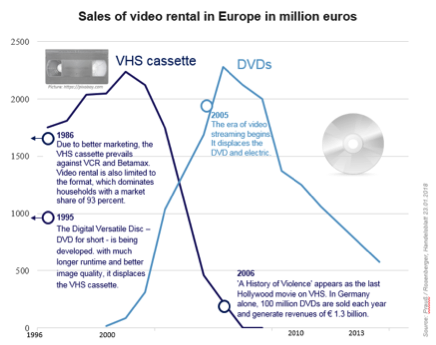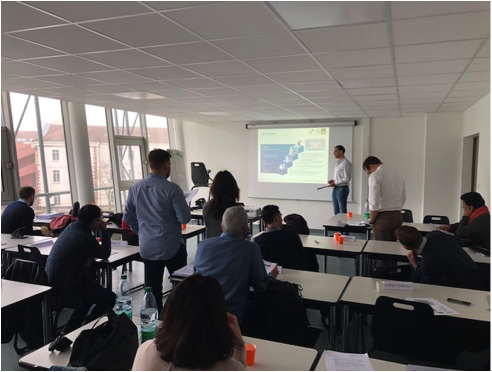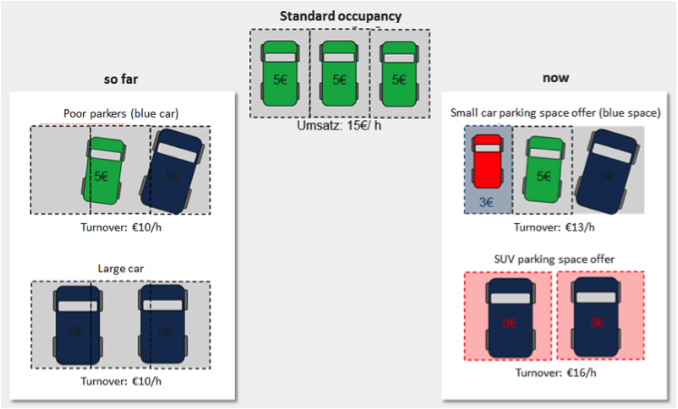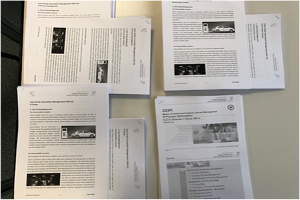MIPLM 2017-18 — 3rd module about innovation management and case study presentations
In March 2018, the MIPLM program proceeded with the 3rd module on innovation management and the integration of IP into the innovation process. The aim of this module was to lead to an understanding of the impact of different types of innovation and related management implications, including learnings about the characterization of disruptive innovation and the “Innovator’s Dilemma” according to Chesbrough. The discussion revolved around the process of technology diffusion and the development of a dominant design according to Utterbark. In addition, practical skills related to integrating IP in innovation management and business model generation with IP design were taught.
The 3rd module of the MIPLM helped students understand the interplay of IP and innovation. Innovation is seen as a process which starts with the idea phase, proceeds to business scenario development and R&D, and culminates in the market launch and the adoption and diffusion of the new service or product in the marketplace. The role of IP as a success factor in the adoption and diffusion of innovation is illustrated by the case of VHS against Betamax – the video recording war. The VHS-DVD case highlights the concept of creative destruction, preemptive patenting and technology marketing with brand positions.
 The further discussion revolved around types of technological innovation such as product and process innovation, incremental and radical innovation, continuous (competence-enhancing) and discontinuous (competence-destroying) innovation, and finally modular and architectural innovation. In addition,, the roles and functions of IP in the different phases of the dominant design process were discussed. The different patterns of innovation for assembled and non-assembled products and their consequences for IP strategies were also demonstrated.
The further discussion revolved around types of technological innovation such as product and process innovation, incremental and radical innovation, continuous (competence-enhancing) and discontinuous (competence-destroying) innovation, and finally modular and architectural innovation. In addition,, the roles and functions of IP in the different phases of the dominant design process were discussed. The different patterns of innovation for assembled and non-assembled products and their consequences for IP strategies were also demonstrated.
One of the key focus areas of the 3rd module was the challenge of managing IP in an innovation stage-gate process. The interdependency of IP and innovation in digital business models involving IoT and Industry 4.0 aspects poses a particular challenge in this respect. The concept and different tools for road mapping with integration of scientific, technological, industry-specific, regulation-specific, and product-specific information about future scenarios and strategic options were also be discussed.
Case Study on IP in Innovation Management
Case Study Background
The electromobility ecosystem
 When thinking about the future of individual mobility today, we cannot ignore the idea of electromobility. The electromobility debate frequently revolves around drive systems and the likely moment at which electric drives will outstrip or indeed completely replace the combustion engine. But electromobility is a topic which requires systemic thinking, i.e. viewing the vehicle as part of an ecosystem. Electromobility must be understood as a holistic concept, from appealing vehicles, rapid charging, driving pleasure, and autonomous driving to tailor-made mobility services, batteries, and power sources from renewable energies. But electromobility extends far beyond the vehicle. This ecosystem includes components as diverse as vehicles, power supply, and transport infrastructure, which must be networked and interlinked in order to enable sustainable mobility beyond established industrial sectors. The focus should always be on the users themselves and their mobility needs.
When thinking about the future of individual mobility today, we cannot ignore the idea of electromobility. The electromobility debate frequently revolves around drive systems and the likely moment at which electric drives will outstrip or indeed completely replace the combustion engine. But electromobility is a topic which requires systemic thinking, i.e. viewing the vehicle as part of an ecosystem. Electromobility must be understood as a holistic concept, from appealing vehicles, rapid charging, driving pleasure, and autonomous driving to tailor-made mobility services, batteries, and power sources from renewable energies. But electromobility extends far beyond the vehicle. This ecosystem includes components as diverse as vehicles, power supply, and transport infrastructure, which must be networked and interlinked in order to enable sustainable mobility beyond established industrial sectors. The focus should always be on the users themselves and their mobility needs.
The electromobility ecosystem
Electromobility not only concerns mobility as such, but also the stationary vehicle.
Drivers in Germany spend a total of 560 million hours looking for free parking spaces, so that even minor efficiency gains would result in enormous savings. According to the renowned economic research institute Prognos, an optimized parking space search would save 125 million liters of petrol, 78 million liters of diesel, and 500,000 tons of CO2 per annum. The ideal scenario would be the following: Strictly speaking, electromobility is about getting from A to B, meaning that the driver would like to get off in B and not in B’, just because that is where the only free parking space is. Ideally, the vehicle would automatically look for an adequate parking space once the driver has gotten off in B. That said, it is always important to also bear in mind the underlying business models in order to find the ideal patent position when looking at the various stages of autonomization. Car parks are an important starting point for making parking more efficient. However, especially in prime locations, there are still many car parks with outdated equipment, resembling dark labyrinths rather than smart places which offer a sense of wellbeing.
Car parks as investment objects
Car parks are regarded as an alternative investment among investors in operator-run properties, office buildings, or commercial real estate. The focus is on the potential return on a car park property. The macroeconomic framework conditions for car park investments are comparatively good. Car registrations are on the up and parking fees in prime locations rise significantly faster than inflation. In addition, there is a tendency for municipalities to increasingly restrict free roadside parking, while at the same time placing a greater focus on paid parking. There is also widespread acceptance for car parks to offer additional services beyond the provision of temporary parking. Modern car parks are increasingly becoming service stations for drivers and car-sharing providers. City locations are ideal as they benefit from a complete and diverse portfolio of customer sources, including retail, restaurants, as well as cultural and healthcare establishments. User preferences must also be taken into account when looking at the location. Difficult to access, convoluted, and dark car parks are met with little or no acceptance from users, even if they are located right in the city center.
With hospitals, for example, a distinction must be made between different groups of users such as staff, patients, and visitors, and their respective preferences. Company car parks should be available to employees, customers, and visitors, while car parks in the city center would be used by office employees during daytime, and by restaurant and cinema visitors in the evening, for instance. Exactly the opposite is true in residential areas. Another differentiating criterion is parking duration. A car park for permanent parkers is characterized by different preference structures to a large shopping center with high continuous throughput during opening hours. Operator companies typically earn their profit with a combination of car park advertising and different fee models. A certain feel-good factor plays an increasingly important role for the acceptance of car parks.
 In contrast to other operator-run properties, there is no such thing as an ideal size for car parks. Commercial success and therefore return on investment depend to a significant extent on whether the location is within strategic proximity to customer sources. Such customer sources include city centers, airports, hospitals, or railway stations. Ultimately, the goal is to optimize the use of the available parking space in order to maximize return on investment. From a cost perspective, the technical equipment of a car park is a critical factor. Floors, coatings (for protection from salty snow water), barriers, management systems, and payment machines must be maintained and ideally be closely linked to the business model. Fitting a typical car park with new car park technology can cost a quarter of a million euros. From the investor’s perspective, frequency of use and parking space occupancy require seamless documentation. In fact, a car park is not just a piece of concrete users enter in order to park their vehicles. In order to optimize car park use, we must establish the exact vehicle movements and user preferences.
In contrast to other operator-run properties, there is no such thing as an ideal size for car parks. Commercial success and therefore return on investment depend to a significant extent on whether the location is within strategic proximity to customer sources. Such customer sources include city centers, airports, hospitals, or railway stations. Ultimately, the goal is to optimize the use of the available parking space in order to maximize return on investment. From a cost perspective, the technical equipment of a car park is a critical factor. Floors, coatings (for protection from salty snow water), barriers, management systems, and payment machines must be maintained and ideally be closely linked to the business model. Fitting a typical car park with new car park technology can cost a quarter of a million euros. From the investor’s perspective, frequency of use and parking space occupancy require seamless documentation. In fact, a car park is not just a piece of concrete users enter in order to park their vehicles. In order to optimize car park use, we must establish the exact vehicle movements and user preferences.
1. Case Study Tasks and Questions
You have been commissioned with creating a brand under which car parks which stand for a unique and individual parking experience will be marketed.
-
- Explain your concept of a garage where the customer can choose their parking experience according to specific preferences.
- What may be end customer’s preferences that should be considered?
- Which benefits does the concept generate for car park operators?
- Explain the 4P concept and how this concept could apply to the case of an individualized parking experience.
- Outline the brand steering wheel for the brand to be created, distinguishing between the resource perspective and the market perspective of the brand steering wheel.
- Explain your concept of a garage where the customer can choose their parking experience according to specific preferences.
Resource perspective
-
- What is the brand competence (heritage) for the case on hand?
- What should be considered in the creation of the brand appearance?
Market perspective
-
- What are the brand benefits for the case on hand?
- What characteristics might the brand tonality have which could be useful for the case on hand?
Please feel free to follow the presentation related to Task 1
2. Case Study Tasks and Questions
IP design is a method that can be used to identify a business model’s core elements from a customer’s point of view and protect these elements by means of IP.
- Outline the core processes of IP management and give a short description of these processes.
- Choose one IP management core process and provide examples for related sub-processes.
- Choose any IP management sub-process and outline the associated workflows.
- Choose the sub-processes identified and define inputs and outputs for these processes.
- Assign the functions related to the IP management process to typical functions in the company.
- Choose a stylized innovation process and outline typical process interfaces with the IP management process.
Please feel free to follow the presentation related to Task 2
3. Case Study Tasks and Questions
IP design is a method that can be used to identify the core elements of a business model from the customer’s point of view and to protect these elements by means of IP.
- Explain how different design thinking methods can be combined into a unified approach to comprehensively describe a concrete usage scenario and its framework conditions.
This description can be used to systematically identify the inventions which are relevant for the customer. - Perform a cognitive walkthrough for the “car in a car park” usage scenario, taking into account the individualized parking experience described in the case study.
- Choose some of the process steps you have identified in the course of the cognitive walkthrough. Apply the AEIOU method to these process steps and present the result in swimlane diagrams.
- The technological tasks required in order to deliver the customer benefit (here: leveraging maximum willingness to pay by satisfying individual parking preferences) can be derived from the description of the usage scenario.
Based on your description of the usage scenario, identify issues which have to be solved by means of technology in order to provide the customer benefit.
Note:
These issues are usually described as real-life tasks (e.g. directing users (in)to the parking bay). - In order to derive the relevant inventions from the possible uniqueness environments which have just been identified, these uniqueness environments must be evaluated and specified further. In particular, the real-life task(s) must be transformed into (a) technological task(s).
Select one of the uniqueness environments you have identified and work out the technological tasks to be performed in order to solve the real-life task. - If a solution for the technological problem is yet to be developed (or if circumvention solutions must also be taken into consideration for the generation of IP), it is advisable to create a systematic breakdown into technological attributes. The targeted modification of these attributes and a more detailed breakdown will reveal alternative solutions.
Select one of the invention cores you have identified, describe the individual points of the technological problem, and derive a number of different features which could solve your problem.
Please feel free to follow the presentation related to Task 3



